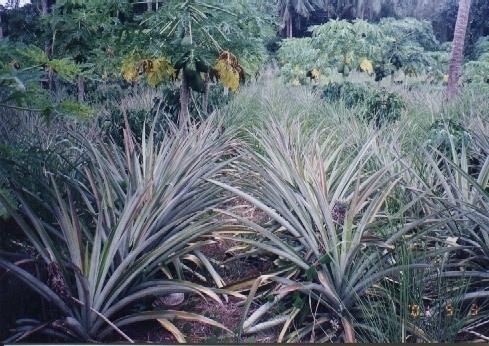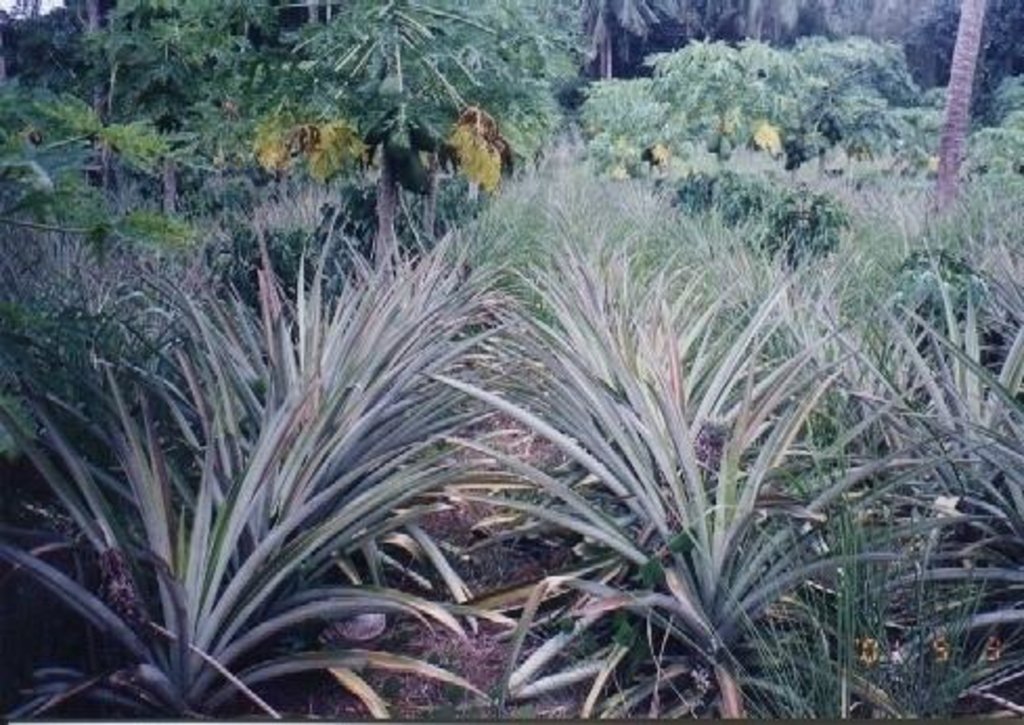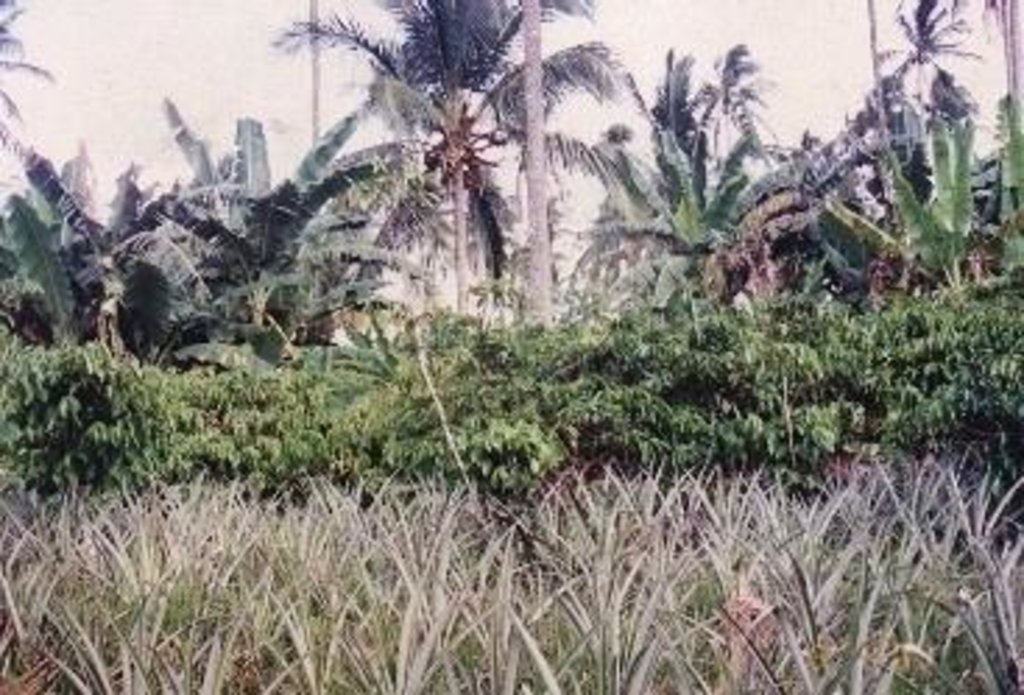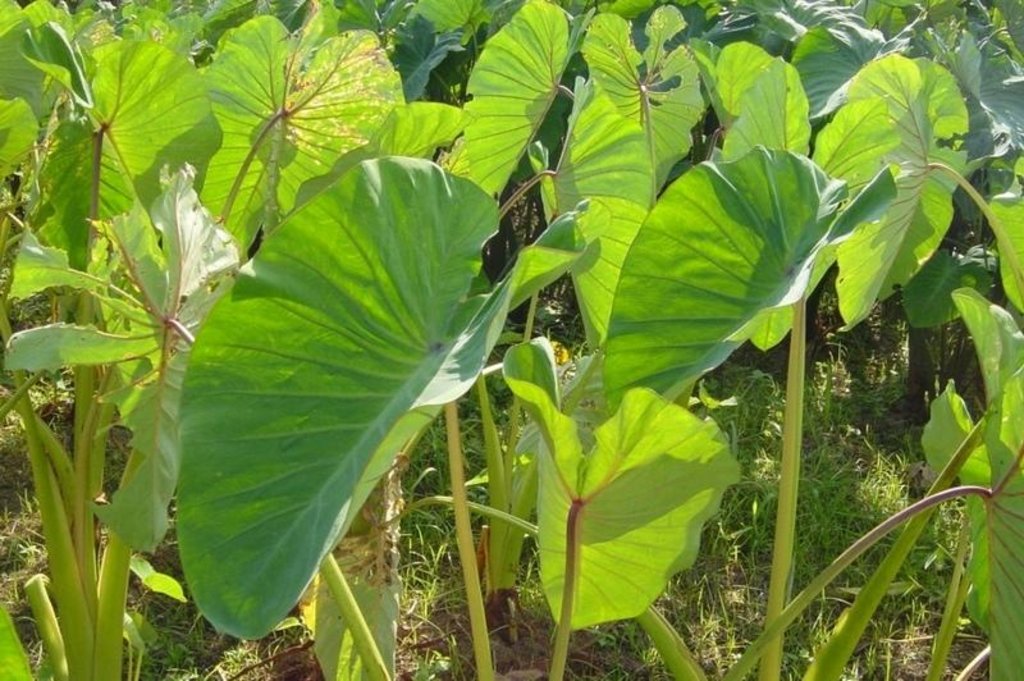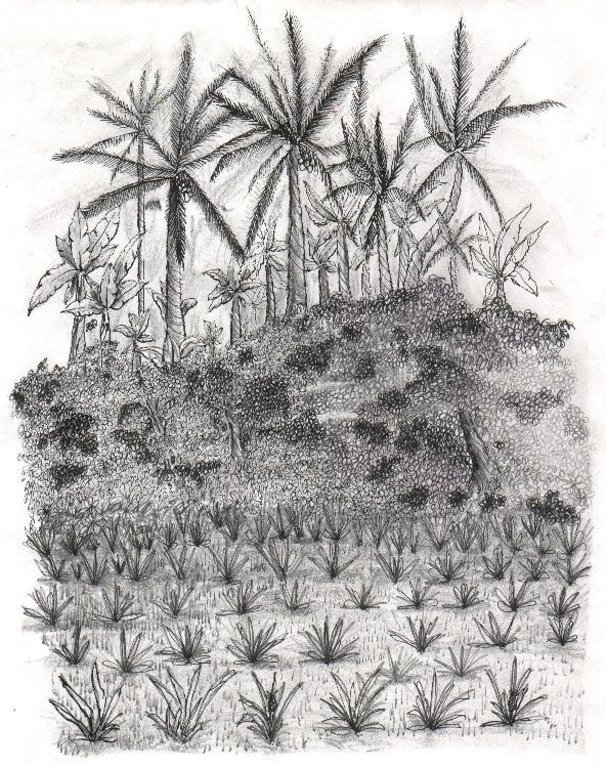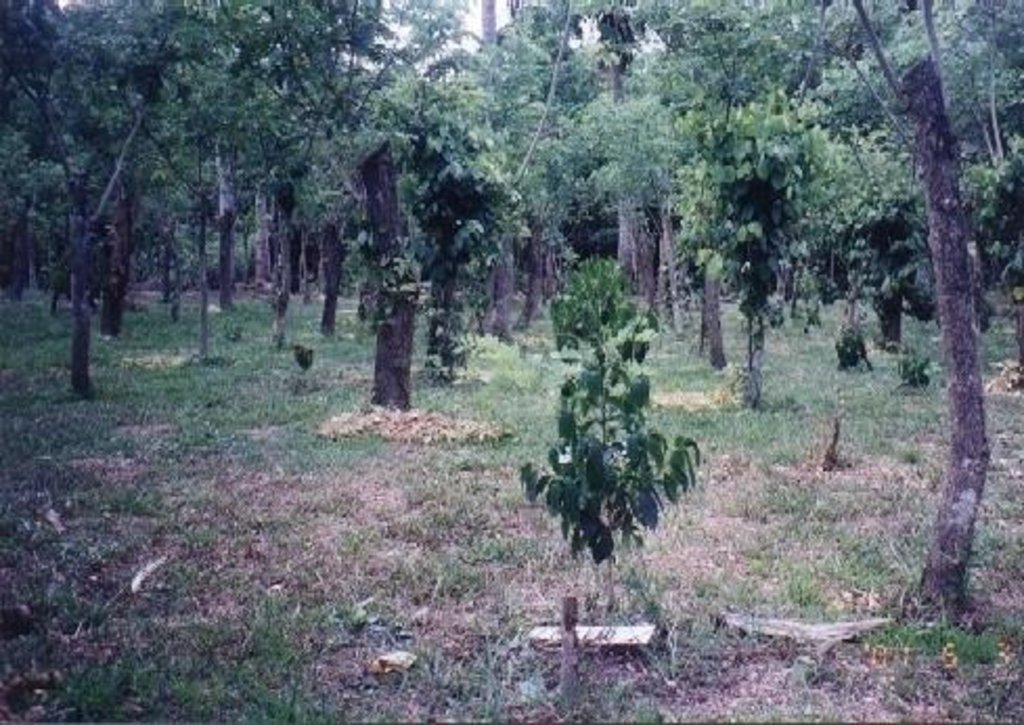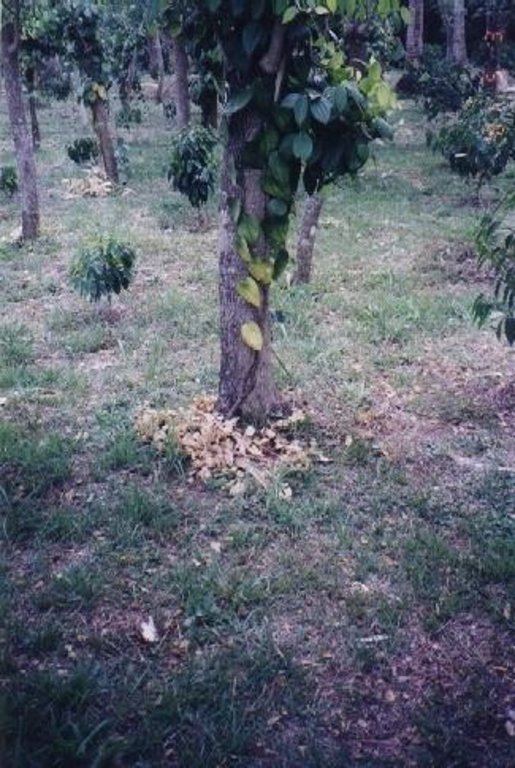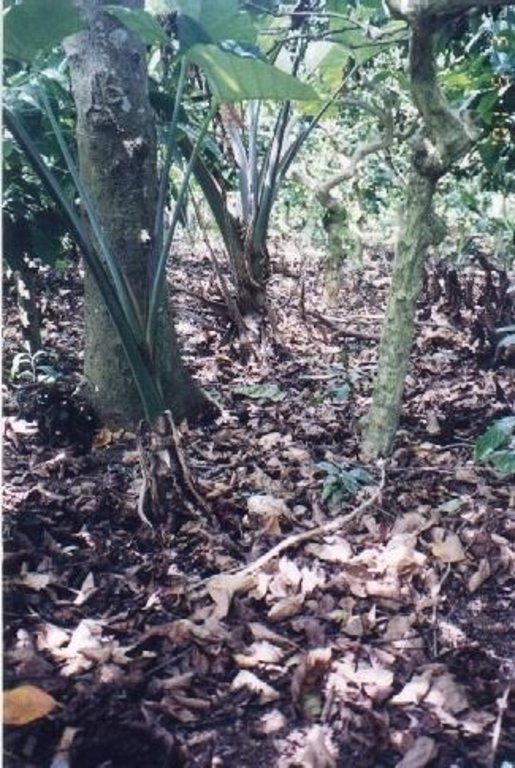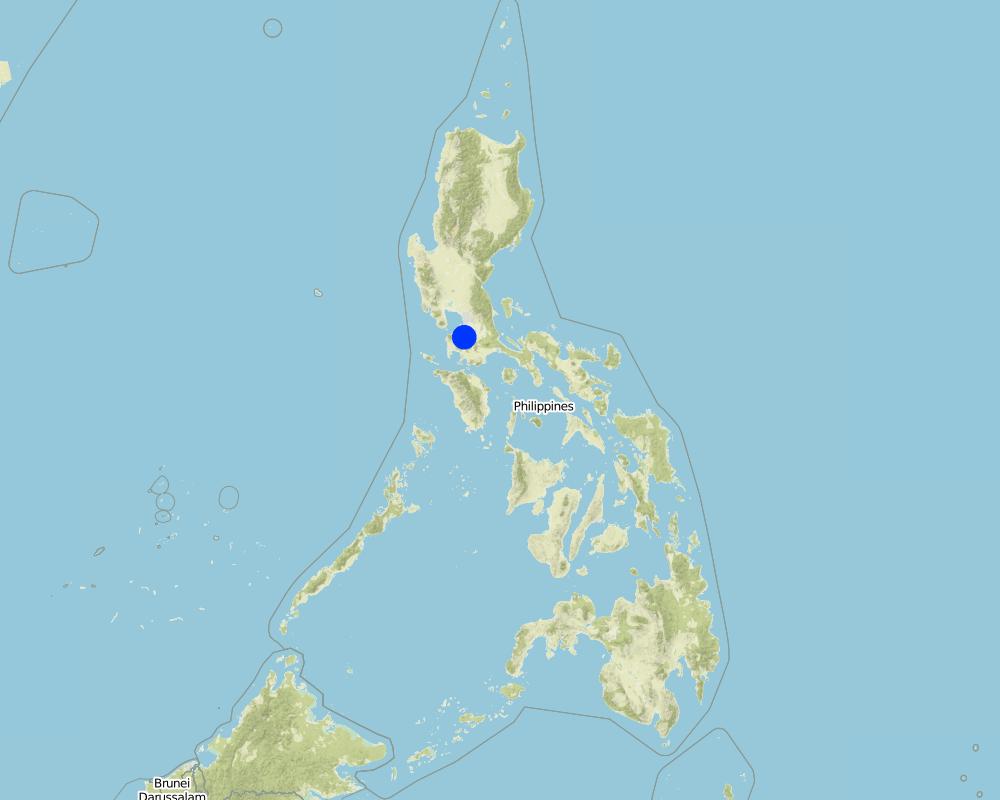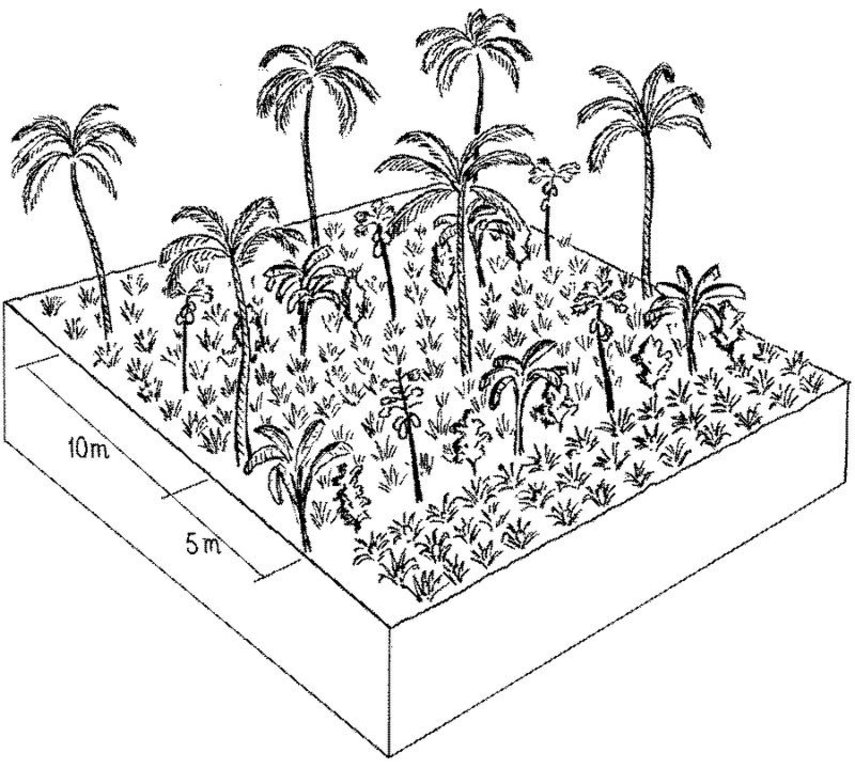Multi-Storey Cropping [Philippines]
- Création :
- Mise à jour :
- Compilateur : Philippine Overview of Conservation Approaches and Technologies
- Rédacteur : –
- Examinateur : Deborah Niggli
Maramihang Pagtatanim or Planting in Great Numbers
technologies_1103 - Philippines
Voir les sections
Développer tout Réduire tout1. Informations générales
1.2 Coordonnées des personnes-ressources et des institutions impliquées dans l'évaluation et la documentation de la Technologie
Spécialiste GDT:
Rondal Jose
joserondal@yahoo.com / bswm@pwolrd.net
Bureau of Soils and Water Management
Diliman, Quezon City, Philippines
Philippines
Spécialiste GDT:
Mojica Alejandro
(046)4150-013 local 256
admojica@cvsu.edu.ph
Cavite State University
Indang, Cavite, Philippines
Philippines
Spécialiste GDT:
Rojales Joseph
632-923-04-59
Bureau of Soils and Water Management
Diliman, Quezon City, Philippines
Philippines
Nom du projet qui a facilité la documentation/ l'évaluation de la Technologie (si pertinent)
Book project: where the land is greener - Case Studies and Analysis of Soil and Water Conservation Initiatives Worldwide (where the land is greener)Nom du ou des institutions qui ont facilité la documentation/ l'évaluation de la Technologie (si pertinent)
Bureau of Soils and Water Management (Bureau of Soils and Water Management) - PhilippinesNom du ou des institutions qui ont facilité la documentation/ l'évaluation de la Technologie (si pertinent)
Cavite State University (CvSU) - PhilippinesNom du ou des institutions qui ont facilité la documentation/ l'évaluation de la Technologie (si pertinent)
Farming Systems and Soil Resources Institute, University of the Philippines Los (Farming Systems and Soil Resources Institute, University of the Philippines Los) - Philippines1.3 Conditions relatives à l'utilisation par WOCAT des données documentées
Quand les données ont-elles été compilées (sur le terrain)?
15/06/2001
Le compilateur et la(les) personne(s) ressource(s) acceptent les conditions relatives à l'utilisation par WOCAT des données documentées:
Oui
1.4 Déclaration sur la durabilité de la Technologie décrite
Est-ce que la Technologie décrite ici pose problème par rapport à la dégradation des terres, de telle sorte qu'elle ne peut pas être déclarée comme étant une technologie de gestion durable des terres?
Non
2. Description de la Technologie de GDT
2.1 Courte description de la Technologie
Définition de la Technologie:
Cultivating a mixture of crops with different heights (multi-storey) and growth characteristics which together optimise the use of soil, moisture and space.
2.2 Description détaillée de la Technologie
Description:
Under the maramihang pagtatanim multi-storey cropping system, perennial crops (coconut, banana, coffee, papaya, pineapple) and annuals/biennials (root crops: taro, yam, sweet potato etc) are interplanted to maximise productivity and income. This is most applicable where farms are small and the system needs to be intensive. In this particular area, Cavite, coconuts are usually planted first. When they reach a height of 4.5 meters (after 3-4 years), bananas, coffee and/or papaya are planted underneath. Black pepper may also be part of the system. After sufficient space has developed at ground level in about three to four years, root crops are planted. At full establishment, the system develops different layers: coconut (tallest) followed by banana, coffee, papaya (middle), root crops and pineapple (lowest). In recent years, because of its relatively low productivity and decreasing price, coconut has tended to be replaced in the system with higher value crops like the fruit tree santol (Sandoricum koetjape), papaya and sometimes black pepper. However most multi-storey farms adhere to no specific planting layout. The multi-storey agroforestry system is intended to make the best use of resources (soil, moisture and space) for increased farm income. It is also very effective against soil erosion. Previously, continuous monocropping of annual crops resulted in erosion and serious soil fertility decline. Even though the land is sloping and rainfall during the monsoon is extremely intensive, multi-storey cropping provides adequate soil cover throughout the year, protecting the land from erosion.
Fertilization, weeding and pruning are necessary elements of maintenance. ‘Natural’ mulching through fallen leaves from leguminous trees helps restore and maintain soil fertility The system is applied in a volcanic-derived soil with distinct wet and dry periods (6 months wet season, 6 months dry season). There is the risk of a destructive typhoon every 10 years. Farm income is relatively high, but labour and input costs are also high - and the technology is mostly used by relatively wealthy landowners. There is strong spontaneous adoption, as maramihang pagtatanim has been proven to be effective and remunerative. This technology has been practiced in Cavite since the 1970s. Implementation is by individual farmers with strong extension support from the Local Government Units (LGUs), NGOs and the Cavite State University.
2.3 Photos de la Technologie
2.5 Pays/ région/ lieux où la Technologie a été appliquée et qui sont couverts par cette évaluation
Pays:
Philippines
Région/ Etat/ Province:
Philippines, Cavite
Autres spécifications du lieu:
Cavite
Map
×2.6 Date de mise en œuvre de la Technologie
Si l'année précise est inconnue, indiquez la date approximative: :
- il y a plus de 50 ans (technologie traditionnelle)
2.7 Introduction de la Technologie
Spécifiez comment la Technologie a été introduite: :
- dans le cadre d'un système traditionnel (> 50 ans)
Commentaires (type de projet, etc.) :
It evolved in the area due to necessity.
3. Classification de la Technologie de GDT
3.1 Principal(aux) objectif(s) de la Technologie
- améliorer la production
- réduire, prévenir, restaurer les terres dégradées
3.2 Type(s) actuel(s) d'utilisation des terres, là où la Technologie est appliquée

Mixte (cultures/ pâturages/ arbres), incluant l'agroforesterie
- Agroforesterie
Commentaires:
Major land use problems (compiler’s opinion): Productivity decline, unstable prices of agricultural products and high costs of inputs are the main land use problems. Inputs also have to be increased to maintain the same yield level in annual cropping systems. There is a severe land use competition: a large proportion of the land is being converted to non-agricultural uses, especially residential and industrial areas because of the proximity to the rapidly expanding capital.
Major land use problems (land users’ perception): Productivity decline and unfavourable prices of agricultural products. High costs of inputs.
3.3 Informations complémentaires sur l'utilisation des terres
Approvisionnement en eau des terres sur lesquelles est appliquée la Technologie:
- pluvial
Nombre de période de croissance par an: :
- 2
Précisez:
Longest growing period in days: 240, Longest growing period from month to month: May - Jan; Second longest growing period in days: 210, Second longest growing period from month to month: May - Dec
3.4 Groupe de GDT auquel appartient la Technologie
- agroforesterie
- Amélioration de la couverture végétale/ du sol
3.5 Diffusion de la Technologie
Spécifiez la diffusion de la Technologie:
- répartie uniformément sur une zone
Si la Technologie est uniformément répartie sur une zone, indiquez la superficie couverte approximative:
- 10-100 km2
Commentaires:
Total area covered by the SLM Technology is 40 m2.
Six adjacent municipalities are practicing multi-storey cropping as a system. This is meant to increase income particularly for small farmers.
3.6 Mesures de GDT constituant la Technologie

pratiques agronomiques
- A1: Couverture végétale/ du sol
- A2: Matière organique/ fertilité du sol
3.7 Principaux types de dégradation des terres traités par la Technologie

érosion hydrique des sols
- Wt: perte de la couche superficielle des sols (couche arable)/ érosion de surface

dégradation chimique des sols
- Cn: baisse de la fertilité des sols et réduction du niveau de matière organique (non causée par l’érosion)
3.8 Prévention, réduction de la dégradation ou réhabilitation des terres dégradées
Spécifiez l'objectif de la Technologie au regard de la dégradation des terres:
- prévenir la dégradation des terres
- réduire la dégradation des terres
4. Spécifications techniques, activités, intrants et coûts de mise en œuvre
4.1 Dessin technique de la Technologie
4.2 Spécification/ explications techniques du dessin technique
Multi-storey cropping includes various species interplanted systematically to optimise use of resources: pineapple and other
root crops (lowest storey); rows of banana trees, coffee and papaya (middle storey); rows of coconut (highest storey). Note: in practice farmers adjust this layout to meet their needs.
Technical knowledge required for field staff / advisors: moderate
Technical knowledge required for land users: moderate
Main technical functions: control of raindrop splash, improvement of ground cover
Secondary technical functions: control of dispersed runoff: retain / trap, increase in organic matter
Mixed cropping / intercropping
Material/ species: coconut, papaya, coffee, banana, pineapple, black pepper, taro, yam...
Quantity/ density: 2500
Remarks: in rows random
Vegetative measure: tree/shrub cover (multi-storey, aligned)
Vegetative material: F : fruit trees / shrubs
Vegetative measure: Vegetative material: F : fruit trees / shrubs
Fruit trees / shrubs species: coconut, coffee, banana, pineapple, black pepper
4.3 Informations générales sur le calcul des intrants et des coûts
autre/ monnaie nationale (précisez):
Peso
Indiquer le taux de change du dollars en monnaie locale (si pertinent): 1 USD= :
50,0
Indiquez le coût salarial moyen de la main d'œuvre par jour:
3.00
4.4 Activités de mise en place/ d'établissement
| Activité | Type de mesures | Calendrier | |
|---|---|---|---|
| 1. | 1. Planting of tallest storey (coconut). | Végétale | early rainy season |
| 2. | 2. Planting of middle storey (coffee and banana). | Végétale | early rainy season |
| 3. | 3. Planting of lowest storey (pineapple). | Végétale | early rainy season |
| 4. | 4. Planting of lowest storey continued (root crops). | Végétale | early rainy season |
4.5 Coûts et intrants nécessaires à la mise en place
| Spécifiez les intrants | Unité | Quantité | Coûts par unité | Coût total par intrant | % des coût supporté par les exploitants des terres | |
|---|---|---|---|---|---|---|
| Main d'œuvre | labour | ha | 1,0 | 150,0 | 150,0 | 100,0 |
| Equipements | animal traction | ha | 1,0 | 50,0 | 50,0 | 100,0 |
| Equipements | tools | ha | 1,0 | 40,0 | 40,0 | 100,0 |
| Matériel végétal | seedlings | ha | 1,0 | 840,0 | 840,0 | 100,0 |
| Engrais et biocides | fertilizer | ha | 1,0 | 160,0 | 160,0 | 100,0 |
| Engrais et biocides | biocides | ha | 1,0 | 30,0 | 30,0 | 100,0 |
| Engrais et biocides | compost/manure | ha | 1,0 | 120,0 | 120,0 | 100,0 |
| Coût total de mise en place de la Technologie | 1390,0 | |||||
Commentaires:
Duration of establishment phase: 60 month(s)
4.6 Activités d'entretien/ récurrentes
| Activité | Type de mesures | Calendrier/ fréquence | |
|---|---|---|---|
| 1. | 1. Pruning. | Agronomique | |
| 2. | 3. Harvesting. | Agronomique | |
| 3. | 2.Weeding | Agronomique | |
| 4. | 4. Spraying. | Agronomique | |
| 5. | 5. Fertilizing. | Agronomique |
4.7 Coûts et intrants nécessaires aux activités d'entretien/ récurrentes (par an)
| Spécifiez les intrants | Unité | Quantité | Coûts par unité | Coût total par intrant | % des coût supporté par les exploitants des terres | |
|---|---|---|---|---|---|---|
| Main d'œuvre | labour | ha | 1,0 | 300,0 | 300,0 | 100,0 |
| Engrais et biocides | fertilizer | ha | 1,0 | 160,0 | 160,0 | 100,0 |
| Engrais et biocides | biocides | ha | 1,0 | 30,0 | 30,0 | 100,0 |
| Coût total d'entretien de la Technologie | 490,0 | |||||
Commentaires:
Machinery/ tools: animal draft wooden plough, machete, iron bar and spade, machetes, harrows, bolo.
Cost was calculated assuming a per hectare population of 100 coconuts, 400 coffee plants and 3,000 pineapples.
Maintenance activities entail more work than during the establishment phase. Note that the establishment phase usually lasts for 4-5 years, so the labour is spread, unlike during the maintenance phase when all of the components have to be attended to.
4.8 Facteurs les plus importants affectant les coûts
Décrivez les facteurs les plus importants affectant les coûts :
Labor is the most crucial especially during land preparation and planting, maintenance and harvesting.
5. Environnement naturel et humain
5.1 Climat
Précipitations annuelles
- < 250 mm
- 251-500 mm
- 501-750 mm
- 751-1000 mm
- 1001-1500 mm
- 1501-2000 mm
- 2001-3000 mm
- 3001-4000 mm
- > 4000 mm
Zone agro-climatique
- humide
Thermal climate class: tropics
5.2 Topographie
Pentes moyennes:
- plat (0-2 %)
- faible (3-5%)
- modéré (6-10%)
- onduleux (11-15%)
- vallonné (16-30%)
- raide (31-60%)
- très raide (>60%)
Reliefs:
- plateaux/ plaines
- crêtes
- flancs/ pentes de montagne
- flancs/ pentes de colline
- piémonts/ glacis (bas de pente)
- fonds de vallée/bas-fonds
Zones altitudinales:
- 0-100 m
- 101-500 m
- 501-1000 m
- 1001-1500 m
- 1501-2000 m
- 2001-2500 m
- 2501-3000 m
- 3001-4000 m
- > 4000 m
5.3 Sols
Profondeur moyenne du sol:
- très superficiel (0-20 cm)
- superficiel (21-50 cm)
- modérément profond (51-80 cm)
- profond (81-120 cm)
- très profond (>120 cm)
Texture du sol (de la couche arable):
- moyen (limoneux)
Matière organique de la couche arable:
- abondant (>3%)
- moyen (1-3%)
5.6 Caractéristiques des exploitants des terres appliquant la Technologie
Orientation du système de production:
- mixte (de subsistance/ commercial)
- commercial/ de marché
Revenus hors exploitation:
- 10-50% de tous les revenus
Niveau relatif de richesse:
- moyen
- riche
Niveau de mécanisation:
- travail manuel
- traction animale
Indiquez toute autre caractéristique pertinente des exploitants des terres:
Population density: > 500 persons/km2
Annual population growth: 2% - 3%
10% of the land users are very rich and own 40% of the land.
60% of the land users are rich and own 40% of the land.
20% of the land users are average wealthy and own 15% of the land.
10% of the land users are poor and own 5% of the land.
Off-farm income specification: remittances from employment of at least one member of the household. Trading is also important.
5.7 Superficie moyenne des terres détenues ou louées par les exploitants appliquant la Technologie
- < 0,5 ha
- 0,5-1 ha
- 1-2 ha
- 2-5 ha
- 5-15 ha
- 15-50 ha
- 50-100 ha
- 100-500 ha
- 500-1 000 ha
- 1 000-10 000 ha
- > 10 000 ha
Commentaires:
Landholding is continuosly being sub-divided due to inheritance
5.8 Propriété foncière, droits d’utilisation des terres et de l'eau
Propriété foncière:
- individu, avec titre de propriété
Droits d’utilisation des terres:
- individuel
6. Impacts et conclusions
6.1 Impacts sur site que la Technologie a montrés
Impacts socio-économiques
Production
production agricole
Commentaires/ spécifiez:
due to high plant population (density)
production de bois
Revenus et coûts
revenus agricoles
Commentaires/ spécifiez:
Farmers in the area are coming the richest
charge de travail
Commentaires/ spécifiez:
during planting/harvesting
Autres impacts socio-économiques
Input constraints
Commentaires/ spécifiez:
system is capital intensive
Impacts socioculturels
institutions communautaires
Commentaires/ spécifiez:
through the formation of cooperatives or farmers organisation
institutions nationales
connaissances sur la GDT/ dégradation des terres
Commentaires/ spécifiez:
through the involvement of line agencies and strengthening of research component
Impacts écologiques
Cycle de l'eau/ ruissellement
ruissellement de surface
Quantité avant la GDT:
70
Quantité après la GDT:
40
Sols
couverture du sol
Commentaires/ spécifiez:
almost 100 % soil cover
perte en sol
Quantité avant la GDT:
10
Quantité après la GDT:
0
Commentaires/ spécifiez:
reduced run-offf
Biodiversité: végétale, animale
diversité végétale
Réduction des risques de catastrophe et des risques climatiques
vitesse du vent
Autres impacts écologiques
Soil fertility
Commentaires/ spécifiez:
organic matter accumulation
6.2 Impacts hors site que la Technologie a montrés
flux des cours d'eau fiables et stables en saison sèche
Commentaires/ spécifiez:
increase aquifer recharge
inondations en aval
Commentaires/ spécifiez:
run-off is reduced
envasement en aval
pollution des rivières/ nappes phréatiques
sédiments (indésirables) transportés par le vent
Commentaires/ spécifiez:
100 % protection of surface
6.4 Analyse coûts-bénéfices
Quels sont les bénéfices comparativement aux coûts de mise en place (du point de vue des exploitants des terres)?
Rentabilité à court terme:
légèrement positive
Rentabilité à long terme:
très positive
Quels sont les bénéfices comparativement aux coûts d'entretien récurrents (du point de vue des exploitants des terres)?
Rentabilité à court terme:
très positive
Rentabilité à long terme:
très positive
6.5 Adoption de la Technologie
Commentaires:
100% of land user families have adopted the Technology without any external material support
1000 land user families have adopted the Technology without any external material support
There is a strong trend towards spontaneous adoption of the Technology. The technology has been proven to be very effective
6.7 Points forts/ avantages/ possibilités de la Technologie
| Points forts/ avantages/ possibilités du point de vue de l'exploitant des terres |
|---|
| Generates high farm income |
| Failure of one crop component can be compensated by the other component |
| Points forts/ avantages/ possibilités du point de vue du compilateur ou d'une autre personne ressource clé |
|---|
| The technology is flexible. It can be modified to suit market condition. Failure of one crop component can be compensated by other components (improved food security) |
| It maintains soil fertility through the recycling of nutrients |
| It is a very effective way of using and conserving water |
| Strong research and development: because of its importance in the economy, the technology has spawned various research activities |
6.8 Faiblesses/ inconvénients/ risques de la Technologie et moyens de les surmonter
| Faiblesses/ inconvénients/ risques du point de vue de l’exploitant des terres | Comment peuvent-ils être surmontés? |
|---|---|
| High investment cost | Government to provide low interest production loans (seeds, fertilizers). |
| Highly fluctuating farm prices | Spread out production schedule. Target off-season harvesting of crop (eg pineapple). |
| Pest and diseases (eg papaya virus, which may have developed because it has been part of the system for a long time) | Intensified research and development. |
| Faiblesses/ inconvénients/ risques du point de vue du compilateur ou d'une autre personne ressource clé | Comment peuvent-ils être surmontés? |
|---|---|
| Prone to typhoon damage | Establishment of windbreaks: Leguminous trees such as Acacias could provide wind protection for lower crops like papaya or coffee. |
| High labour requirement (eg weeding, harvesting).Weeding may be reduced for some components (eg coffee), but pineapple always requires difficult (due to its thorny leaves) and intensive weeding. | (1) Use labour-reducing techniques (eg mulching), (2) spread activities over the growing season. |
7. Références et liens
7.1 Méthodes/ sources d'information
- visites de terrain, enquêtes sur le terrain
- interviews/entretiens avec les exploitants des terres
7.2 Références des publications disponibles
Titre, auteur, année, ISBN:
Field Report: Multi-Storey Cropping System of Silang, Cavite, Philippines
Disponible à partir d'où? Coût?
Bureau of Soils and Water Management, Diliman, Quezon City, Philippines
Titre, auteur, année, ISBN:
FAO and IIRR. Resource management for upland areas in Southeast Asia. FARM Field Document 2. 1995.
Disponible à partir d'où? Coût?
Food and Agriculture Organisation of the United Nations, Bangkok, Thailand and International Institute of Rural Reconstruction, Silang, Cavite, Philippines.
Liens et modules
Développer tout Réduire toutLiens
Aucun lien
Modules
Aucun module trouvé


